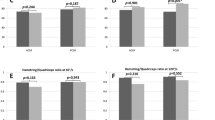Abstract
Introduction
Anterior cruciate ligament (ACL) reconstruction using hamstring tendons has recently received attention because of less donor site morbidity. It has been reported that harvesting hamstring tendons has little effect on postoperative hamstring muscle performance based on the peak torque value of the hamstring strength. However, recent studies have clarified some adverse effects of harvesting hamstring tendons. There is still argument about the influences of harvesting hamstring tendons on postoperative hamstring muscle performance. The purpose of this study was to evaluate the postoperative hamstring muscle performance measured by various parameters after harvesting hamstring tendons for ACL reconstruction.
Patients and methods
We evaluated the postoperative hamstring muscle performance after harvesting hamstring tendons in 58 patients who underwent ACL reconstruction. We assessed peak torque value, total work, and peak torque angle in the isokinetic hamstring strength test and active knee flexion angle. We classified the patients into three groups according to the type of hamstring used for ACL reconstruction: 1) the autologous semitendinosus tendon (ST); 2) the autologous ST and the gracilis tendon, which were harvested from the ipsilateral knees; and 3) allogeneic fascia lata.
Results
This study clearly demonstrated that the peak torque value and total work in the patients in each group compared to preoperative normal knees were not statistically different; however, the more hamstring tendons were harvested, the more loss of active knee flexion angle was observed and the more the peak torque angle was shifted to a shallow angle, suggesting that the hamstring strength might be weaker at the deep flexion angle.
Conclusion
Physicians should recognize that the ACL reconstruction using autologous hamstring tendons is not appropriate for sportsmen or women who are required to flex their knees deeply or powerfully in their performance.




Similar content being viewed by others
References
Butler DL, Noyes FR, Grood ES (1980) Ligamentous restraints to anterior-posterior drawer in the human knee. J Bone Joint Surg Am 62:259–270
Carter TR, Edinger S (1999) Isokinetic evaluation of anterior cruciate ligament reconstruction: hamstring versus patella tendon. Arthroscopy 15:169–172
Cho KO (1975) Reconstruction of the anterior cruciate ligament by semitendinosus tenodesis. J Bone Joint Surg Am 57:608–612
Clancy WG, Nelson DA, Reider B, Narechania R (1982) ACL reconstruction using one third of the patellar ligament, augmented by extra-articular tendon transfers. J Bone Joint Surg Am 64:352–359
Fowler PJ, Regan WD (1987) The patient with symptomatic chronic anterior cruciate ligament insufficiency: results of minimal arthroscopic surgery and rehabilitation. Am J Sports Med 15:321–325
Fukubayashi T, Ikeda K, Niitsu M (1994) Changes in muscle volume after anterior cruciate ligament reconstruction using semitendinosus and gracilis tendons (in Japanese). Hiza (The Knee) 20:124–128
Graf B, Uhr F (1990) Complications of intra-articular anterior cruciate reconstruction. Clin Sports Med 7:835–848
Howe JG, Johnson RJ, Kaplan MJ, Fleming B, Jarvinen M (1991) Anterior cruciate ligament reconstruction using quadriceps patellar tendon graft. Part I. Long-term follow up. Am J Sports Med 19:447–457
Karlson JA, Steiner ME, Brown C, Johnston J (1994) Anterior cruciate ligament reconstruction using gracilis and semitendinosus tendons. Comparison of through-the-condyle and over-the-top graft placements. Am J Sports Med 22:659–666
Lipscomb AB, Johnston RK, Snyder RB, Brothers JC (1979) Secondary reconstruction of anterior cruciate ligament in athletes by using the semitendinosus tendon. Am J Sports Med 7:81–84
Lipscomb AB, Johnston RK, Snyder RB, Warburton MJ, Gilbert PP (1982) Evaluation of hamstring strength following use of semitendinosus and gracilis tendons to reconstruct the anterior cruciate ligament. Am J Sports Med 10:340–342
Markolf KL, Mensch JS, Amstuts HC (1976) Stiffness and laxity of the knee: the contribution of the supporting structures. J Bone Joint Surg Am 58:583–593
Nakajima R, Maruyama Y, Shitoto K, Yamauchi Y, Nakajima H (1996) Hamstring muscle strength after ACL reconstruction with the semitendinosus and gracilis muscles (in Japanese). Rinsho Sports Igaku (J Clinical Sports Med) 13:681–686
Noyes FR, Mooar PA, Mathews DS, Butler DL (1983) The symptomatic anterior cruciate-deficient knee. Part I. The long-term functional disability in athletically active individuals. J Bone Joint Surg Am 65:154–162
O'Brien SJ, Warren RF, Pavlov H, PanarielloR, Wickiewicz TL (1991) Reconstruction of the chronically insufficient ACL with the central third of the patellar ligament. J Bone Joint Surg Am 73:278–286
Ohkoshi Y, Inoue C, Yamane S, Hashimoto T, Ishida R (1998) Changes in muscle strength properties caused by harvesting of autogenous semitendinosus tendon for reconstruction of contralateral anterior cruciate ligament. Arthroscopy 14:580–584
Rosenberg TD, Franklin JL, Baldwin GN, Nelson KA (1992) Extensor mechanism function after patella tendon graft harvest for anterior cruciate ligament reconstruction. Am J Sports Med 20:519–526
Sachs RA, Daniel DM, Stone ML, Garfein RF (1989) Patellofemoral problems after anterior cruciate ligament reconstruction. Am J Sports Med 17:760–765
Takai S, Woo SL, Livesay GA, Adams DJ, Fu FH (1993) Determination of the in situ loads on the human anterior cruciate ligament. J Orthop Res 11:686–695
Yasuda K, Tsujino J, Ohkoshi Y, Tanabe Y, Kaneda K (1995) Graft site morbidity with autogenous semitendinosus and gracilis tendons. Am J Sports Med 23:706–714
Acknowledgements
This experiment complies with the current laws of this country.
Author information
Authors and Affiliations
Corresponding author
Rights and permissions
About this article
Cite this article
Adachi, N., Ochi, M., Uchio, Y. et al. Harvesting hamstring tendons for ACL reconstruction influences postoperative hamstring muscle performance. Arch Orthop Trauma Surg 123, 460–465 (2003). https://doi.org/10.1007/s00402-003-0572-2
Received:
Revised:
Published:
Issue Date:
DOI: https://doi.org/10.1007/s00402-003-0572-2




